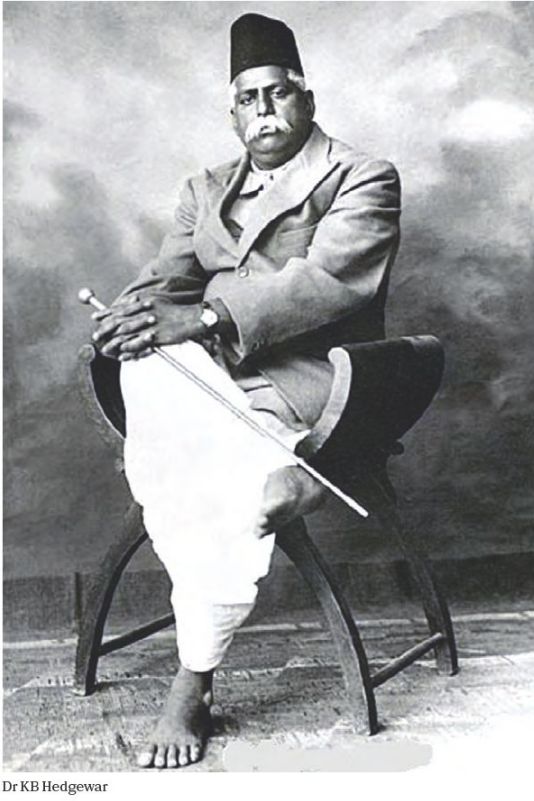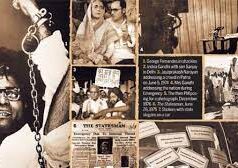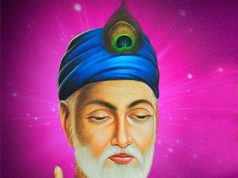
As per Hindu Calendar Chaitra Shukla Pratipada is Dr Hedgewar’s birth anniversary. According to the Gregorian calendar, it falls on April 1. The seeds of RSS were sown with a gathering of small youngsters by Dr KB Hedgewar in 1925. Now it has turned into a huge tree encompassing all walks of national life. Here is a tribute to this visionary organiser and born patriot on his birth anniversary.
Beneath his calm and composed demeanour lay a fearless patriot with unparalleled courage, determination and idealism. He was a visionary who had dedicated himself to the cause of national emancipation. Fondly known as “Doctorji”, the founder of Rashtriya Swayamsewak Sangh, Dr Keshav Baliram Hedgewar (1889-1940), was a ‘human magnet’ whose charm was inescapable. It was his sincere affection and warmth that lay at the root of this charisma. This was the man who could inspire his countrymen like never before and with his utter dedication and sterling character, his unsurpassed organising ability and spirit of self-effacing service founded a social organisation to provide character training through the Hindu way of life and to unite the Hindu community. Beneath his soft exterior lay a tough interior, that of a man who was to usher in truly the first phase of Hindu revival.
Dr Hedgewar was the true Hindu renaissance leader!
A Born Patriot
With Shivaji, the great Hindu redeemer as his hero, the eight-year old Keshav was far more mature than children of his age. His fiery streak of patriotism began to manifest in early school itself when he threw the sweets offered to him on the occasion of an imperial celebration being held to commemorate the coronation of Queen Victoria. He told his friends not to eat the sweets which he felt bore the bitter taste of slavery that the nation was being subjugated to. His reactions were unusual as Nagpur where he was growing up was then untouched by the flames of the freedom struggle. Neither did his home carry the environment of nationalist fervor. And yet, the little boy’s imagination was fired by the stories of contemporary heroes of the freedom movement that he read in pamphlets and books which made him loathe foreign domination and bondage.
Early Signs of a Master Organiser
Young Keshav was a master organiser and started motivating young minds effectively. A determined and irrepressible boy, he organised his schoolmates to sing Vande Mataram at the time when it was banned. In 1907, when the school inspector made a field visit to the school, he was received with Vande Matram greetings. The daredevil act led to the closure of the school for many days. After mediation from parents every student was asked to apologise before the head master for the event. However, a defiant Keshav stated that he had every right to worship his Mother and refused to apologise. Consequently, he was thrown out of the school. Later he completed his matriculation from Poona and went to Calcutta for medicine studies; the city was the centre of revolutionary activities.
Resolute and Sprightly
Dr Hedgewar returned to Nagpur in 1916 after completing the medical course at Calcutta. Everyone including his family expected that he would begin his medical practice. But even after the lapse of several months, he showed no signs. In addition to other social pressures there were also proposals for marriage which he vehemently ruled out stating that the nation needed his full and undivided attention. He said there was no place for self in his life until the country remained subjugated. He spent all his time thinking and planning on how to uproot such a tremendously organised and well equipped alien British Government. Doctorji became actively involved in all kinds of freedom movements from armed rebellion to non-violent satyagraha. This took him to jail while participating in mass movements led by Mahatma Gandhiji, be it Non-Cooperation or Civil Disobedience.
Far-sighted and Global Thinking
He was instrumental in organising the Congress session of Nagpur in 1920, for which he even recruited some 1200 volunteers. Significantly enough, he also proposed to the All India Working Committee that Congress should aim towards complete political independence of Bharat and liberating the world from the clutches of Capitalism.
When the Congress adopted the ‘Complete Independence’ resolution at the Lahore session in December, 1929, every Shakha was advised to celebrate the announcement on January 26, 1930. A proposal which had been made by Doctorji a decade ago was adopted by Congress now which only shows how far-sighted he was!
Lokasangrah—Connecting All and Everybody
It was the time when the people here were divided into different factions like Tilakites and Gandhians within Congress, Congress and the revolutionary stream, the Congress and the Hindu Mahasabha and so on. However, it was exceptional and unique that Doctorji had a cordial relationship with all of them. It is notable that he was comfortably near and dear to all factions. That is why in 1921, when Berar state Congress committee under the leadership of Lokanayak Bapuji Ane was about to adopt a resolution condemning revolutionaries, Doctorji met Loknayak Ane and pleaded that, “We understand that you don’t appreciate and approve of their methods. However, you cannot suspect their patriotism. It is not right that instead of fighting the British imperialism we are fighting amongst each other”. It was in this background that the Congress eventually dropped the resolution.
A True Mass Leader
Dr Hedgewar participated in the mass movement of 1921. Since going to jails was considered patriotic in those times, presenting a case of defence in the court was dubbed as irresolute. However, Doctor ji never approved of it. He participated in Satyagraha, defended himself in the court, defended the right to self-defence, refused to avail the granted bail, and went to jail.
The words of Doctorji at that moment when the verdict was passed are never to be forgotten and will continue to blaze a trail for all generations to come.
“As you are aware, I have defended myself in this case of sedition against me. However, these days, there is an impression going round that arguing in one’s defence is an act of treachery to the national movement. But I feel it is highly unwise to merely get crushed like a bug when a case is foisted upon us. It is our duty to expose to the whole world the wickedness of the foreign rulers. That would indeed be an act of patriotism. And not to defend ourselves, on the other hand, would be a suicidal policy.”
He continued, “You may, if you so choose refuse to defend yourself; but for God’s sake don’t consider those who disagree with you as being less patriotic. If in the course of our patriotic duty we are called upon to enter the prison or be transported to the Andamans, or even face the gallows, we shall have to willingly do so. But let us not be under the illusion that jail-going is all in all, that it is the only path for achieving freedom. There are, in fact, so many fields of national service awaiting us outside the prison. I would be back amongst you after one year. Till then, of course, I will not be in touch with the national movement, but I am confident that by then the movement for Complete Independence will have gained added momentum. Now, it is no more possible to keep down Hindusthan under the heels of foreign domination. I offer my gratitude to you all and bid you good-bye.”
Even when he didn’t approve of Mahatma Gandhi’s solidarity with the Khilafat movement, he had no issues in working with him. He was convinced that mutual disagreements should not weaken the battle against British imperialism. When he was released from the prison, thousands of people were there to receive him even on a rainy day. Amidst greetings and salutations, he said, “I have not gained any merit by going to prison. If you all really believe that, then thank the British.” He was extended a reception in the Venkatesh auditorium personalities like Vitthalbhai Patel, Pandit Motilal Nehru, C Rajgopalachari, Dr Ansari, etc. were in attendance. There also, he repeated that it is unjust to believe that only going to jail is patriotism.
Sangh’s Approach—Team Work
While participating in the freedom movement in every way Doctorji’s insightful pondering led to a conclusion that our lack of unity, identity and self-esteem had divided our society in warring factions which had helped the British to subjugate and rule this ancient civilization. Hence the prime and fundamental task is to unite the entire society inculcating national character and self-esteem.
It was with this thought that the Sangh was founded on the auspicious day of Vijayadashmi in October, 1925. It was named as the Rashtriya Swayamsewak Sangh in a meeting held along with 22 Swayamsevaks in April, 1926. All these Swayamsevaks were junior to Dr Hedgewar in age, experience and thought. Even then, he made the process inclusive and participatory. He did that, not only because he had to name the organisation, but because he wanted to establish the benchmark of the approach and methods to be adopted in the future by his successors. He asserted that each one must be included in the decision making process, and thus, he made the Sangh synonymous to team work.
Atypical Self-Reliant Style of Working
In those times, as even now, it was normal to ask for contributions from prosperous class for social work. Sangh also followed the same in the first two years of its foundation. However, Doctor ji wished for self-reliance and suggested that whatever was required for Sangh, be it, time, labour, sacrifice, or wealth, had to be contributed by the Swayamsevaks. The work of Sangh had to be considered as one’s own toil. Doctor ji visualised the concept of ‘Guru Dakshina’. Since Swayamsevaks were mostly students then, they but extra efforts to earn money to contribute as Gurudakshina.
Doctorji emphasised that Sangh is not a mere organisation in the society, but is an organisation of the entire society. Therefore, we must have an ancient symbol as Guru which is a manifestation and identity of our glorious past, and therefore Bhagwa Dhwaj was fixed. Bhagwa (Saffron) is the symbol of knowledge, sacrifice, and light. That’s why, the popular and easily acceptable Bhagwa dhwaj was chosen by him.
Doctorji said, “The Rashtriya Swayamsevak Sangh does not recognise any individual as its Guru. The sacred Bhagawa Flag alone is our Guru. An individual, however great, is after all temporal and imperfect. The individual is conditioned by time; it is the principle alone which is timeless. The Bhagawa Flag symbolises that timeless principle.”
Task of Hindu Consolidation
Dr Hedgewar was never reluctant to utilise modern means for inculcating attributes of unity and discipline in Hindu society, which he felt was the need of the hour. The concept of uniform was new to Hindu society. But to create unity and discipline among swayamsevaks he introduced uniform and military parade thinking it to be instrumental. It was with great difficulty that money was raised for purchasing the first ever musical instruments for band. There was no tradition of parade in Hindu society till then. In early years the commands were same as in British army which were translated into Sanskrit commands later.
Not just institution, Organisation of Society
Even after the foundation of the Sangh, Dr Hedgewar moved over in 1930 to participate in the Civil disobedience movement in his individual capacity. The Jungle Satyagraha of Vidarbha had not succeeded even after two attempts. When Doctorji’s turn came and he decided to join the Jungle Satyagraha, thousands of people came along. Before he left for Pusad for the Forest Satyagraha, he was given a reception farewell in Nagpur where he made clear that he was participating as a swayamsevak and not representing the Sangh. There could be other volunteers as well. Moreover, he made arrangements so that Sangh could also continue while he was away. He handed over the responsibility of Sarsanghachalak to his old friend Dr LV Paranjape. Colleagues Bapurao Bhedi and Babsaheb Apte were given the responsibility of maintaining the growing network of Shakhas.
An Egoless Make-up
When he was given salutations in 1929 after being chosen Sarsanghchalak by consensus, he observed, “I am hesitant when salutations come from those who are revered and superior to me.” To this, Appaji Joshi replied that even if Doctor ji doesn’t approve this he has to honour the collective decision of Sangh.
He publicly said the following in the meeting of Sarsanghchalak in 1931, “I am well aware that I am not the founder of the Sangh, all of you are. I am discharging my duty respecting your wishes and will. While doing so, I won’t ever bother about my health and comforts. I will be standing up to the given responsibility till you consider me worthy. When you think of a more worthy person, pass the responsibility to him. I would happily pass on this responsibility to your chosen successor and continue working under him as a Swayamsevak.” The founder of Sangh, the founder of an organisation could be so ego-less is something which is unparalleled.
Shankaracharya of Kurtkoti gave him the title of “Rashtra Senapati” in 1934. The news circulated in the newspapers and congratulatory messages started floating in. Doctor ji notified to all Shakhas that no one in Sangha will use this title for him as such titles are not at all appropriate for them.
Let’s Work Together to realise his Dream
Even after a spell of long illness, Dr Hedgewar came to visit the “Sangh Shiksha Varga” in 1940. It was against the advice of his medical consultants; he came and with great difficulty addressed the swayamsevaks from all major parts of the country. His opening statement upon reaching there was- “Off late, I could not serve you because of my ill health, and I apologise for that. I have come here for your darshan.” He reiterated that Sangh work is not just limited to Shakha alone; it has to be done in the society at large beyond Shakha.
What the visionary leader built was an inherently strong organisation that was self-reliant and growing. It is his unique approach that led RSS to reach where it has today. The revolutionary and radical work style defying all norms of those times led the way for a cadre-based disciplinary workforce dedicated to the cause of a resurgent Bharat. It was due to this inherent strength despite many obstacles and hurdles, the organisation has been working through its fifty-five thousand Shakhas from Ladakh to Andamans, and from Manipur-Tripura to Kutch, for last six generations. Today, this noble work of organising Hindu society is being done by Swayamsevaks across thirty five countries. In countries like Kenya and Columbia, the methodology and approach of RSS has become exemplary and is being used and applied for creating similar social structures among the local communities.
The philosophy of Dr Hedgewar is more and more relevant even day and in modern age when the dream of a resurgent Bharat is yet to be fulfilled. He was the greatest ever patriot and unifying force that India ever saw. The core of his philosophy was ‘sacrifice for the nation’. On his birth anniversary on April 1, let us once again pay our obeisance to this true son of the soil. Let us all salute him and pledge to come together and work towards achieving his yet Unfulfilled Dream of a Glorious Hindu Rashtra!
By Dr Manmohan Vaidya
(The Writer is a Sahsarkaryavah of Rashtriya Swayamsevak Sangh)
Courtesy: Organiser














